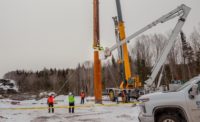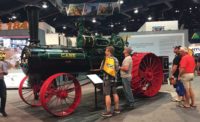Transportation
Record-Breaking Heavy Transport Gets Underway in Nevada

The 2.4-million-lb load hit surface streets on Monday morning around 4:00 a.m., leaving from the Apex Industrial Park in North Las Vegas, and entering U.S. Highway 93 northbound at around 8:00 a.m.
Image by Tony Illia, courtesy Nevada Dept. of Transportation
The heaviest load to travel on Nevada highways in the state’s history inched its way out of Las Vegas in the early morning hours of June 29, beginning the first leg of a 345-mile trip that will take it mostly along two-lane roads to the Utah border.
The transport assembly, anchored by six heavy-duty Class 8 trucks with four tractors pushing and two pulling, is hauling a 770-ton reactor pressure vessel previously used for cooling at the Southern California Edison’s San Onofre Nuclear Generating Station, 45 miles of north of San Diego. The ultimate destination is Energy Solutions’ Nuclear Waste Facility in Clive, Utah, 75 miles west of Salt Lake City.
“This record-sized move over state highways marks the culmination of over a year of planning and coordination across three states,” says Nevada DOT spokesman Tony Illia. “At 2.4 million total pounds, it’s the heaviest load ever to cross Nevada roadways.”
The vessel, which was decommissioned 28 years ago, arrived by rail on May 28 at the Apex Industrial Park in North Las Vegas, where it was staged until time for the trip north.
Transport contractor Emmert International lifted the 15.5-ft-dia., 1.47-million-lb canister off the railcar onto a 24-axle, 21-ft-wide custom trailer using hydraulic jacks. The 122-ft-long, 384-tire German-made Goldhofer transport trailer arrived in eight pieces that were assembled on site.
The six Mack and Kenworth trucks are connected by tow bars to create a 23-ft-tall by 306.5-ft-long frame—nearly as long as the Statue of Liberty laid on its side. The entire assembly, powered by a combined 4,000 hp, weighs the equivalent of 200 elephants. [View a video of the convoy north of Las Vegas.]
Emmert crews have dispersed the weight across 460 tires, each up to 18 in. wide, to distribute the load and help prevent major damage to roads, bridges and drainage facilities along the way.
“The contractor has reinforced up to nine drainage culverts along the route using hydraulic jacks to prevent damage to public infrastructure,” Illia says.
The transport presents almost no radiation danger, he adds. The 38.5-ft-long, 2-in.-thick, carbon steel cylindrical canister has the least hazardous radioactive waste classification available by the Nuclear Regulatory Commission, at less than 0.1 millirem an hour or 500 times below the U.S. Dept. of Transportation limit. By comparison, a chest X-ray provides a dose of 10 millirem.
The convoy, escorted by the Nevada State Patrol, is moving at only five to 10 mph, and will take eight days to reach the Utah border. The group includes extra trucks, mechanics, project managers and state troopers, resulting in a convoy that’s one to two miles long.
The tentative travel route, which will keep the load off Interstate 15, is taking U.S. Highway 93 north to State Route 318, then U.S. Highway 6 back onto U.S. Highway 93, exiting at Wendover Boulevard to Florence Way and back along Interstate 80 into Utah.
It will travel Monday through Friday from one-half hour before sunrise to one-half hour after sunset and won’t be on the road during the July 4 holiday, NVDOT says.
Emmert International is the same firm responsible for moving Howard Hughes’ Spruce Goose to the Evergreen Aviation & Space Museum in McMinnville, Ore.




